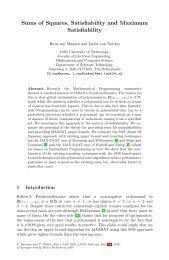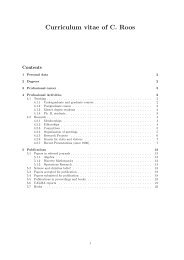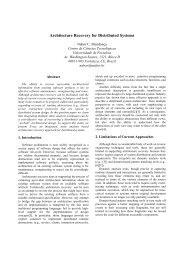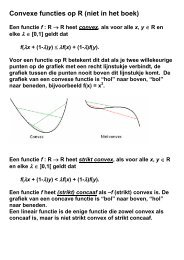Full-Newton step polynomial-time methods for LO based on locally ...
Full-Newton step polynomial-time methods for LO based on locally ...
Full-Newton step polynomial-time methods for LO based on locally ...
Create successful ePaper yourself
Turn your PDF publications into a flip-book with our unique Google optimized e-Paper software.
<str<strong>on</strong>g>Newt<strong>on</strong></str<strong>on</strong>g> <str<strong>on</strong>g>step</str<strong>on</strong>g> and proximity measureLet φ : D → R be a a strictly c<strong>on</strong>vex κ-SC functi<strong>on</strong> having a minimizer, and such that theminimal value equals 0. The <str<strong>on</strong>g>Newt<strong>on</strong></str<strong>on</strong>g> <str<strong>on</strong>g>step</str<strong>on</strong>g> at x is defined by∆x = −H(x) −1 g(x), (2)where g(x) and H(x) denote the gradient and the Hessian of φ(x) at x, respectively. Inthe sequel we always assume that φ is strictly c<strong>on</strong>vex. As a c<strong>on</strong>sequence, the quantity√√λ(x) = ∆x T H(x)∆x = ‖∆x‖ H(x) = g(x) T H(x) −1 g(x),can be used as a measure <str<strong>on</strong>g>for</str<strong>on</strong>g> the ‘distance’ of x to the minimizer of φ(x).The quantity λ(x) plays a crucial role in the analysis of <str<strong>on</strong>g>Newt<strong>on</strong></str<strong>on</strong>g>’s method. Many results canbe nicely expressed by using the univariate (n<strong>on</strong>negative) functi<strong>on</strong> ω(t) defined byFor example, if λ(x) < 1 κthen <strong>on</strong>e hasω(t) = t − ln(1 + t), t > −1. (3)κλ(x) + ln(1 − κλ(x))φ(x) ≤ −Hence, since ω(t) is m<strong>on</strong>ot<strong>on</strong>ically decreasing if t ∈ (−1,0], we obtainλ(x) ≤ 1 4κκ 2= ω (−κλ(x))κ 2 .⇒ φ(x) ≤ ω(−1 4 )κ 2 = 0.0376821κ 2 ≤ 126κ 2. 5
















